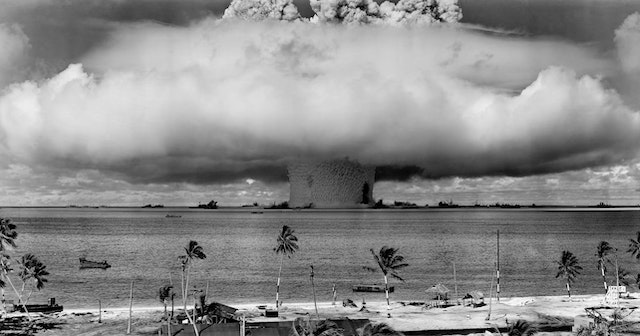
How does a nuclear bomb work? By splitting the nucleus of an atom and releasing the energy.
There are two ways to make energy from an atom: fusion and fission. Fusion is the process that happens in our sun. The sun fuses four hydrogen atoms together to make one helium atom. One helium atom has a slightly lower mass than four hydrogen atoms and this difference in mass is released as energy. It is very difficult to conduct fusion on Earth. Fusion reactors are coming along, but they are still a way away. Fission is the splitting of an atom that we are going to talk about today. The early nuclear bombs were pure fission bombs. More modern nuclear bombs are both fission and fusion. There is no way to make a pure fusion bomb at the moment.
So, how does a nuclear bomb work? Let’s look at a fission bomb first. These were the type of bombs that were dropped on Hiroshima and Nagasaki at the end of World War II. A fission bomb uses the energy stored in the nucleus of an atom to make a huge amount of damage.
Every atom is made up of neutrons, protons, and electrons. The neutrons and the protons are held together by the strong force and they form the nucleus. The electrons orbit around the nucleus. The protons always have a positive charge, the electrons have a negative charge, and the neutrons are neutral. The positively charged protons try to repel each other, but the strong force that is one of the four fundamental forces of the universe holds them together. Most atoms have an equal number of protons and neutrons and they are stable atoms, which means the strong force holds them together easily. If you add an extra neutron, it puts extra energy in the nucleus, and the atom becomes unstable. Atoms don’t like to be unstable and they quickly break down into stable forms. This can be releasing neutrons, or breaking into lighter elements.
Nuclear fission happens when an unstable atom is bombarded with neutrons to give it energy and push it over the brink to break into lighter elements. For example, Uranium-235 is the common fuel used in nuclear weapons. It is 235 because it has 92 protons and 143 neutrons. It is an unstable element, but not very unstable. If it receives an extra neutron, the extra energy will be enough to cause the Uranium-235 to break into two lighter elements, krypton-92 and barium-141. 92 plus 141 is 233. Those extra two neutrons are released in the reaction. The two new elements are lighter than the original Uranium-235 and this mass is released as energy in the form of heat or light.
If there is only one atom split, then only a small amount of energy will be released. A nuclear bomb wouldn’t be any use if that was all it did. The bomb needs to have the reaction reach a critical mass. That means that when neutrons are released from an atom, those neutrons hit another atom and the reaction is repeated again and again, until all of the Uranium-235 has been converted. The critical mass is what makes nuclear bombs so destructive.
The original nuclear bomb that was dropped on Hiroshima, called Little Boy, was a fission bomb. The bomb was 3.2 m long and weighed 4.4 tons. It carried 64 kg of Uranium-235. The bomb was dropped from the plane, the Enola Gay, and had a pressure sensor plus radar detectors to track its height. At 600 m above the city, an explosive charge detonated, thrusting a hollow piece of Urabium-235 into a shaped piece of Uranium-235. Neutrons were introduced at the same time and the reaction went critical. However, despite having 64 kg of Uranium-235, only 1 kg of it underwent nuclear fusion and only 0.7 g of that produced the energy. The bomb had an efficiency of 1.5% and yet it devastated the city. Imagine if it had been more efficient. Fat Man, dropped on Nagasaki, used plutonium-239 and was 17% efficient.
Scientists were impressed, but needed a way to improve the efficiency. They realized that a fusion reaction would produce more neutrons than a fission reaction can. The trouble is, fusion powers the sun, but it needs the pressure of temperature that the sun can generate to work. To use fusion in a bomb meant creating those temperatures. If they could do it, they could use the fusion reaction to put more neutrons into the fuel to make the fission reaction far more efficient. Scientists came up with thermonuclear bombs, which does just that.
A thermonuclear bomb has three stages. It starts with a regular fission bomb. This explodes, producing X-rays and heat. The enormous heat and pressure causes the secondary fuel to undergo nuclear fusion. This produces more heat and neutrons which enter the third fuel source, inducing nuclear fission. This takes about 600 billionths of a second and produces a far more efficient explosion. The Soviet Union denotated the Tsar Bomba in 1961. It was a thermonuclear bomb and it produced an explosion of 58,000,000 tons of TNT. Little Boy produced 15,000 tons of TNT. Nuclear bombs have come a long way. That is not good.
So, a nuclear bomb works by adding a neutron to an unstable element to make it break into two lighter elements and release energy. The reaction also releases more neutrons, which continue the reaction. And this is what I learned today.
Sources
https://nrl.mit.edu/reactor/fission-process
https://www.nde-ed.org/Physics/AtomElements/stableunstableatoms.xhtml
https://www.epa.gov/radtown/radtown-radioactive-atom-activity-4-atomic-stability
https://www.wtamu.edu/~cbaird/sq/2013/08/08/why-dont-electrons-in-the-atom-enter-the-nucleus/
https://science.howstuffworks.com/nuclear-bomb.htm
https://www.atomicarchive.com/science/fission/little-boy.html
